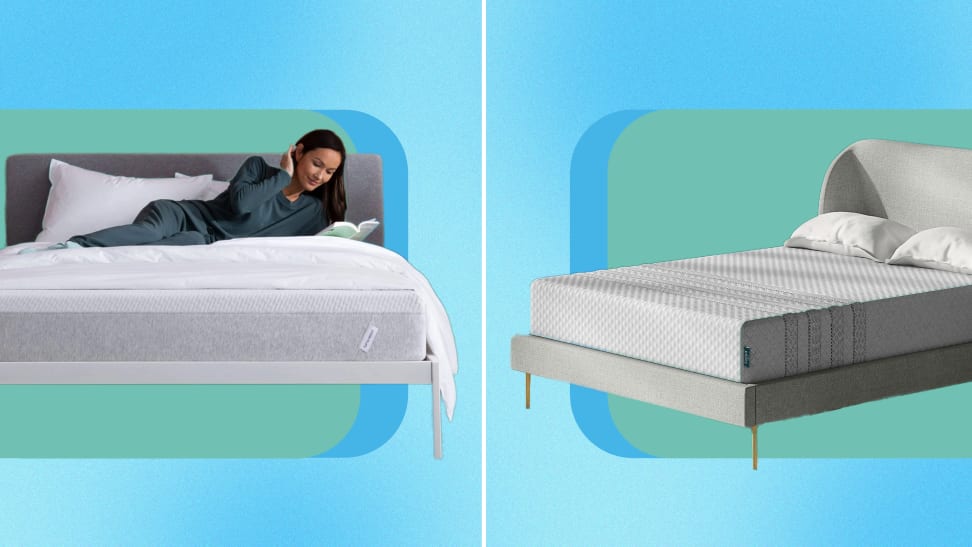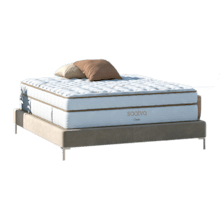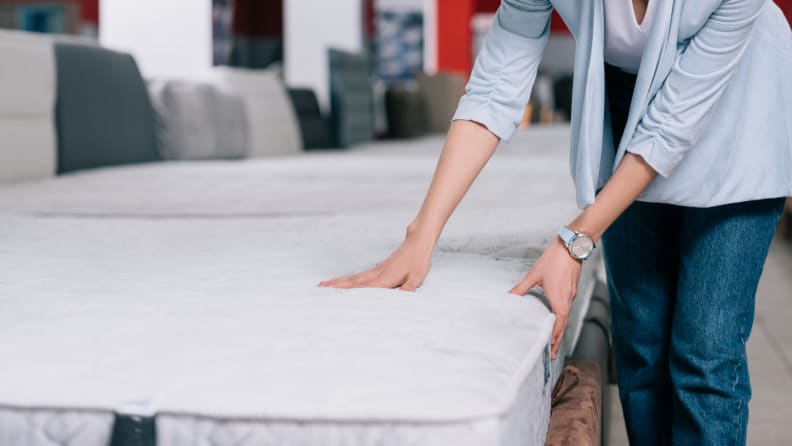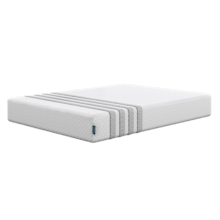 Credit:
Reviewed / Tuft & Needle / Leesa
Credit:
Reviewed / Tuft & Needle / Leesa
Recommendations are independently chosen by Reviewed's editors. Purchases made through the links below may earn us and our publishing partners a commission. Prices were accurate at the time this article was published but may change over time.
We spend roughly a third of our lives sleeping on a mattress, equating to about 2,555 hours per year. With so much of our time spent asleep, you need the best mattress to support your dead weight at night.
There are thousands of mattresses to choose from and foam and spring mattresses are some of the most popular options. Which one is right for you? We break down the differences between foam vs. spring mattresses to help you get the best night's rest.
Foam vs. spring mattresses: What’s the difference?
Spring mattresses

The Saavta Classic uses a dual-coil design made of recycled carbon steel to reduce mattress sagging.
Spring mattresses, or innerspring, contain a base layer of coil springs that provide support and cushioning. Various coils are used in spring mattresses, such as Bonnell, Offset, and Continuous Wire. However, the most common type is the pocket spring: a series of individual coils wrapped in fabric. Pocket spring bases help the mattress adjust to pressure and provide targeted support and compression.
We haven't tested many innerspring mattresses but one of the better options we have is the Saatva Classic available at Saatva.

The Saatva Classic is a great choice for folks who want outstanding edge support and an easy delivery experience.
Buy now at SaavtaFoam mattresses

Foam mattresses tend to contour to your body's natural shape so your rest remains uninterrupted by pain.
Foam mattresses have no springs and often include a blend of various layers of memory foam and polyurethane foam, plus other materials such as cotton, wool, and/or polyester.
If you've shopped online for a mattress in the last ten years, you’ve undoubtedly encountered an increasing number of all-foam mattresses. Foam mattress toppers began to be added to spring mattresses in the 1960s with the invention of specialty foams. Foam mattresses are a popular option thanks to the arrival of mattress-in-a-box brands like Casper in the last decade and developments in memory foam construction.
Foam reduces pressure points and relieves pain because it molds “to the shape of your body as your weight shifts through the night. Memory foam also absorbs movement, so if you sleep with a partner, you’re not likely to be disturbed by their tossing and turning,” says David Rubin, a certified sleep science coach known as the “Sleep Doctor.”
The best foam mattress we have tested is the Tuft & Needle Original which is affordable and impressive.

Tuft & Needle is personalizing your sleep experience with the Original mattress which is more ideal for back and stomach sleepers who want a firm, cooling option.
Buy now at Tuft & NeedleFoam vs. spring mattresses: Which one is right for you?

Purchasing a new mattress can become a lengthy process—especially because it's a long-term buy.
Unfortunately, when it comes to foam and spring mattresses, it’s impossible to say which is the better option. As with many decisions in life, personal preferences are top considerations. Whether sleeping alone or with a partner or pet, discussions about different options are necessary.
That said, there are certain trends we have noticed when testing mattresses. Foam mattresses can offer superior pressure point relief and are often a better choice for side sleepers looking for a cradling surface. Foam mattresses might also be a better choice for couples as the density of the materials used, their construction does a better job of isolating motion.
Spring mattresses on the other hand offer a greater level of stability and support, especially for heavier individuals. Spring mattresses have plenty of spaces between each innerspring, with creates a greater potential for airflow, which helps them keep cooler at night.
If you aren't enticed by the wonders of online mattress shopping, then nothing solidifies a choice like seeing, feeling, and lying down on several mattresses in a retail store. If you have always slept on spring mattresses and have slept well, try testing those types of mattresses first to experience different firmness levels.
However, don’t leave stores without comparing the experience of a foam mattress to a spring mattress.
“Comfort is very subjective to each sleeper,” says Mary Helen Rogers, vice president of marketing and communications, Better Sleep Council. “The most important factor in selecting a mattress is that it provides both comfort and support to you and your sleeping partner. This means your head, neck, and spine are in proper alignment when you are in your preferred sleeping position. This is why we suggest that mattress shoppers do the research before they buy.”
Rogers recommends thinking about durability, price, and lifespan when deciding between foam vs. spring mattresses. And, since the price range is so vast, from hundreds to thousands for a new mattress, she recommends “investing in a quality and supportive mattress is investing in your own health and wellness.”
If this all sounds overwhelming, don’t worry too much about making the wrong choice the first time around. Many mattress stores and online brands offer free trial periods that allow you to test out the mattress and return it within a certain period of time if you are not satisfied.
But what about hybrid mattresses?

If you associate uncomfy, pesky springs with the word 'mattress,' then you haven't met the Leesa Sapira Hybrid, which is a balanced blend of pocket springs and foam.
If you’ve done your research and still cannot decide between foam or spring—or are in conflict with your partner over firmness preferences, it might be time to look beyond an all-foam or traditional spring mattress.
For indecisive shoppers, hybrid mattresses are a suitable, happy medium. Firm- and soft-preferred sleepers can find satisfaction in a hybrid, which some consider the ideal marriage of foam and spring.
Hybrids are spring mattresses with a thick layer of foam on the top. In order to be classified as a hybrid, the foam layer must be at least 2 inches thick. Many manufacturers offer hybrid-type mattresses, merging what some consumers consider the best of both worlds for optimal sleep.
If you’re considering a hybrid mattress, then It’s hard to beat the Leesa Sapira Hybrid available at Leesa it’s the perfect blend of cushioning and support.

The Leesa Sapira Hybrid was crafted with comfort in mind due to the cooling foam technology for hot sleepers and use of pocket springs that continue to move as you do throughout the night.
Buy now at LeesaThe product experts at Reviewed have all your shopping needs covered. Follow Reviewed on Facebook, Twitter, Instagram, TikTok or Flipboard for the latest deals, product reviews, and more.





